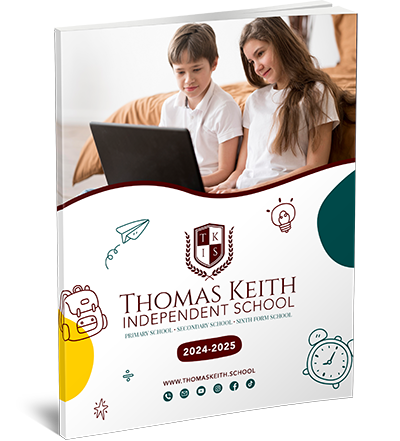
KS1 Books
A Guide To KS1 Books
A child’s early education is greatly impacted by Key Stage 1 (KS1), which covers Years 1 and 2 in the UK educational system. Through the development of reading, writing, numeracy, and world awareness, this stage establishes the foundation for lifelong learning. Books for KS1 are designed to help children through this stage of development by providing interesting, developmentally appropriate content that improves vocabulary, understanding, and curiosity. These books cover many different subjects and make difficult concepts easy for the children to understand. The KS1 books that are chosen can have a big impact on keeping them engaged, motivated, and ready to learn.
In this post, we discuss key subjects found in KS1 textbooks and provide advice on how educators and parents may select the best materials. We also examine how the Thomas Keith Online Independent School supports KS1 learning through the use of useful books and resources. Whether you are a parent or an educator, this book will give you useful advice on how to make well-informed decisions on KS1 reading.
Why Are Books in Year 1 Important?
Among the basic subjects included in the KS1 curriculum are English, Math, Science, History, Geography, and Art. Every subject is enhanced by KS1 books, which make learning engaging and participatory. They are made to inspire self-expression and curiosity while assisting young students in developing their reading confidence. The key advantages of KS1 books are as follows:
- Vocabulary Development: KS1 books help the children grow their vocabulary by introducing them to new terms.
- Concept Understanding: To clarify complicated subjects, many KS1 books employ straightforward language and visuals.
- Interactive Learning: Children are actively involved in learning through the activities or questions that are frequently included in books.
- Reading skill development: KS1-level books aid in the growth of children’s fluency, understanding, and love of reading.
How to Pick the Best KS1 Books
There is so much to choose from when it comes to KS1 novels that it might be daunting. To help you make an informed decision, take into account the following:
- Interests of the Child: Selecting books according to a child’s interests might enhance the pleasure of reading. Books on animals or their habitats can infuse learning with excitement and relevance for children who have a strong affinity for animals.
- Topic Coverage: Make sure the books address English, math, science, history, and other key subjects from the KS1 curriculum.
- Reading Level: To guarantee comprehension and foster growth, KS1 books should be just a little bit challenging but still appropriate for the child’s reading level.
- Illustrations & Design: Interesting images can enhance the pleasure of reading and facilitate the easier explanation of difficult concepts.
![]()
Suggested Books and Subjects for Grade 1
Here are some ideas for interesting and instructive novels for each of the main subjects discussed in KS1 literature.
- Developing Literacy Skills with English and Phonics
Children’s reading, writing, and phonics skills are the main goals of KS1 English books. To help with reading and spelling, the program emphasises phonics.
Phonics-Focused Books: For KS1 students, phonics-based books like the Oxford Reading Tree and Phonics Bug series are wonderful. These books methodically present sounds which hhelpsimplify and make reading more accessible.
Novels: Novels such as Julia Donaldson’s The Gruffalo or Room on the Broom are perfect for stimulating young readers’ imaginations. Reading these novels is made enjoyable by their simple sentence structures and rhymes.
- Math: Gaining Numeracy Skills
KS1 math books address fundamental ideas including numbers, time, addition, subtraction, and basic geometry. They support rational reasoning and problem-solving.
Books on basic arithmetic: Maths No Problem! and Busy Ant Maths are two examples of books that use compelling illustrations and simple exercises to convey ideas.
Interactive Math Books: Books that emphasise counting skills through entertaining storytelling include Mike Brownlow’s Ten Little Pirates.
- Science: Investigating Our Around Us
Children can learn about the natural world and scientific principles through the introduction of subjects including plants, animals, weather, and seasons in KS1 science books.
Books about nature and animals, such as Usborne Beginners: The First Facts About Animals: Great resources for educating children about various species and habitats are found on Our Planet.
Books that involve easy experiments that the children can try under adult supervision include books like Big Book of Science Things to Make and Do. This type of book makes learning interactive and hands-on.
- Geography and History: Studying the Past and In the Present
The KS1 curriculum’s foundational subjects of geography and history aid in teaching the children about the world’s variety and their origins.
Historical Stories: Children can learn about historical events entertainingly with books like Emma Adams’ The Great Fire of London.
Children can explore various countries and continents using interactive geography books like Aleksandra Mizielińska’s Maps.
- Developing Character through Social and Emotional Learning (SEL)
Social and emotional learning books can help children learn about their own emotions and other people’s viewpoints. This subject is frequently included in the KS1 curriculum to encourage kindness, empathy, and resilience.
Books about Emotions: Jo Witek’s In My Heart: A Book of Feelings is an excellent resource for teaching children how to recognise and communicate their feelings.
How to Be a Lion: Stories of Friendship and Kindness by Ed Vere imparts important lessons about kindness and self-acceptance.
- Imagination and Art: Fostering Creativity
Art books foster fine motor skills, creativity, and self-expression. Since it allows the children to interact with the world through visual means, art is an essential part of KS1 education.
Books on crafts: Scholastic’s My First Art Book offers simple craft projects that are appropriate for KS1 pupils.
Book Illustrations: Rob Biddulph’s Draw with Rob provides detailed drawing lessons that are well-liked by young students.
A Successful Learning Example Using Thomas Keith Online Independent School
By combining online materials with interactive learning, Thomas Keith Online Independent School provides a novel approach to KS1 teaching. Using top-notch KS1 literature in all subject areas is emphasised by the school to promote a well-rounded education. Students have access to a variety of suggested books that address key KS1 subjects through digital platforms, enabling flexibility and individualised instruction.
The school incorporates books into its digital teachings by offering reading assignments and interactive tests that reinforce important concepts. For example, a child may read a chosen storybook before participating in phonics exercises in English. To practice fundamental arithmetic abilities entertainingly, internet resources are a great addition to KS1 math textbooks. To improve learning results, this approach shows how a well-rounded, carefully chosen selection of KS1 books can be successfully included in a contemporary curriculum.

Some Pointers for Making the Most of KS1 Books
The following techniques can help parents and teachers get the most out of KS1 books:
Read Aloud Together: Children can enjoy stories while learning new words and expressions when they are read aloud, which also improves their listening abilities.
Encourage Questions: To pique children’s interest, encourage them to pose inquiries regarding the material they have read.
Combining with Activities: To make learning more interactive and hands-on, use books with activities like basic scientific experiments or math puzzles.
Talk and Think: To improve understanding and promote critical thinking, talk about the tale or subject after reading it.
![]()
Final Thoughts
More than just teaching resources, KS1 books serve as doors for young minds to explore, learn, and be creative. Teachers and parents can promote a well-rounded, engaging educational experience by choosing books that complement each child’s interests and reading ability while covering a variety of subjects. Good KS1 books give the children the groundwork they need to appreciate learning and gain a better grasp of the world.
Answers to Common Questions (FAQs)
Q1: KS1 books what are they?
A: KS1 books are instructional materials designed for pupils in Key Stage 1, usually those between the ages of 5 and 7, and they include core subjects like science, math, social studies, and English.
Q2: How do I pick the top KS1 books?
A: Select books for your child’s KS1 curriculum depending on their reading ability, hobbies, and the subjects they cover. Choose interactive features and captivating images.
Q3: Do phonics books have to be used for KS1?
A: Children may learn the link between letters and sounds, which is a critical skill for early reading, with the aid of phonics books.
Q4: How do KS1 math books fit into the curriculum?
A: K-1 Learning is made interesting by math books, which teach fundamental math concepts and logical reasoning through entertaining illustrations and exercises.
Q5: The utilisation of KS1 books at Thomas Keith Online Independent School.
A variety of KS1 books are used in several disciplines at the school to augment digital learning with interesting reading resources that facilitate both guided and autonomous learning.
Children can be given the necessary resources for a well-rounded education and set up for a good academic future by knowing and choosing the appropriate KS1 books.







